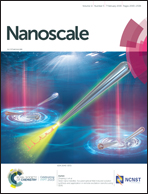Quantum 3D thermal imaging at the micro–nanoscale†
Abstract
Real-time and accurate measurement of three-dimensional (3D) temperature field gradient maps of cells and tissues would provide an effective experimental method for analyzing the coupled correlation between metabolism and heat, as well as exploring the thermodynamic properties of nanoparticles under complex environments. In this work, a new principle of quantum 3D thermal imaging is proposed. The photoluminescence principle of quantum dots is expounded and CdTe QDs are prepared by aqueous phase synthesis. Fluorescence spectral characteristics of QDs at different temperatures are studied. The optimized algorithm of the optical spot double helix point spread function is proposed to improve the imaging, where optimized light energy increased by 27.36%. The design scheme of a quantum 3D thermal imaging system is presented. The measurement range is (−8 mm, +8 mm). The temperature is calculated according to the temperature–heat curve of quantum dots. The double helix point spread function has converted the defocus distance of QDs into the rotation angle of the double optical spot, thereby determining its position. The experimental results reveal that real-time 3D tracking and temperature measurements of quantum dots at the micro–nanoscale are achieved. Overall, the proposed nano-scale 3D quantum thermal imaging system with high-resolution may provide a new research direction and exploration of many frontier fields.



 Please wait while we load your content...
Please wait while we load your content...